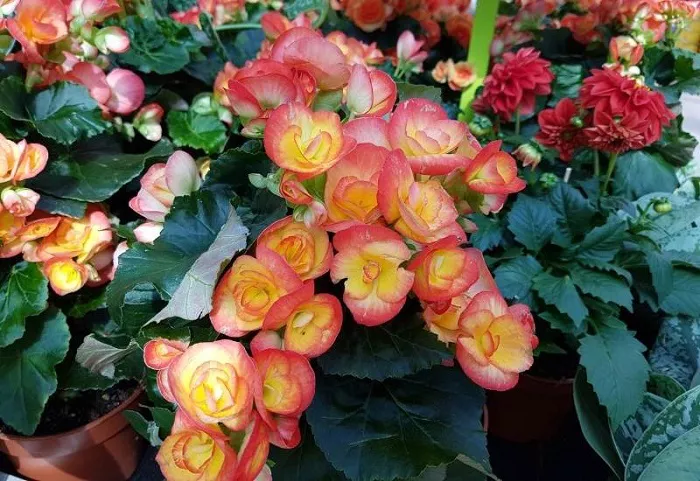Begonias, with their vibrant colors and delicate petals, are a common sight in many gardens. But can these beautiful flowers be eaten? This article will explore the edibility of begonia flowers, their potential culinary uses, and important considerations for those interested in adding a touch of floral flavor to their meals.
Introduction to Begonias
Begonias are a diverse group of flowering plants, known for their ornamental value. With over 2,000 species and cultivars, they come in a variety of shapes, sizes, and colors. From the lush foliage of rex begonias to the stunning blooms of tuberous begonias, these plants are beloved by gardeners worldwide. However, their appeal extends beyond aesthetics. In some cultures, begonia flowers have been used in cooking, adding a unique dimension to culinary traditions.
The Edibility of Begonia Flowers
While many flowers are purely decorative, begonia flowers are indeed edible. They have been used in various cuisines for centuries, particularly in regions such as Southeast Asia and Central America. The flowers of most begonia species are safe to eat, though it is essential to ensure they are grown organically, without pesticides or chemicals. Their taste can vary, ranging from a mild citrus flavor to a slightly tangy or peppery note, depending on the species.
Nutritional Benefits
Begonia flowers offer more than just visual appeal and flavor. They are a source of vitamins and minerals, including vitamin C and potassium. These nutrients contribute to overall health and well-being, making begonia flowers a nutritious addition to your diet. Additionally, their low calorie content means they can be enjoyed without significant impact on daily caloric intake.
Culinary Uses
Begonia flowers can be incorporated into a variety of dishes, adding a touch of elegance and unique flavor. They are often used in salads, where their vibrant colors and delicate taste complement fresh greens and other ingredients. In some recipes, begonia flowers are used to garnish soups or desserts, providing a visually stunning and aromatic element.
Salads
One of the simplest ways to enjoy begonia flowers is in a fresh salad. Tossing a few petals with mixed greens, cherry tomatoes, and a light vinaigrette creates a visually appealing and flavorful dish. The flowers can also be paired with fruits like strawberries or citrus, enhancing the overall taste profile.
Soups and Stews
In traditional cooking, begonia flowers are sometimes added to soups and stews. They can be used towards the end of cooking to preserve their delicate flavor and texture. This technique adds a subtle floral note to the dish, making it more complex and interesting.
Desserts
Begonia flowers can also be used in desserts, such as cakes, cookies, or ice cream. They can be candied or used as a decorative element on top of pastries. Their natural sweetness and delicate flavor make them a perfect addition to sweet treats.
Safety Considerations
While begonia flowers are generally safe to eat, there are a few important considerations to keep in mind. First, it is crucial to identify the species correctly, as some plants may have toxic look-alikes. Additionally, individuals with allergies or sensitivities to certain plants should exercise caution when trying new edible flowers. It is always best to start with a small amount to ensure there are no adverse reactions.
Growing Your Own Begonias
If you are interested in using begonia flowers in your cooking, growing your own plants is a great option. This allows you to ensure they are free from pesticides and chemicals. Begonias thrive in well-drained soil and partial shade, making them suitable for many garden environments. With proper care, they can produce beautiful blooms that are both visually stunning and edible.
Planting and Care
When planting begonias, choose a location with well-drained soil and partial sun. Water regularly, but avoid overwatering, as this can lead to root rot. Fertilize occasionally to encourage healthy growth and abundant blooms. With the right conditions, begonias can thrive and provide a continuous supply of edible flowers.
Harvesting
To harvest begonia flowers for culinary use, choose blooms that are fully open and in good condition. Handle them gently to avoid bruising or damaging the petals. Rinse them lightly under cool water to remove any dirt or insects, then pat them dry with a soft cloth. Store them in the refrigerator until you are ready to use them.
Creative Ways to Use Begonia Flowers
Beyond traditional culinary applications, begonia flowers can be used in a variety of creative ways. They can be infused into oils or vinegars, creating unique flavorings for cooking. They can also be used to make herbal teas, adding a delicate floral note to your favorite blends.
Infusions
Infusing begonia flowers into oils or vinegars is a simple way to capture their flavor. Place the flowers in a clean jar and cover them with oil or vinegar. Allow the mixture to steep for several weeks, then strain and use the infused liquid in your cooking. This technique can add a subtle floral note to salad dressings, marinades, or sauces.
Teas
Begonia flowers can also be used to make herbal teas. Simply steep a few petals in hot water for a few minutes, then strain and enjoy. You can also combine begonia flowers with other herbs and flowers to create unique blends. Their mild flavor makes them a versatile addition to tea recipes.
Conclusion
Begonia flowers are not only beautiful but also edible and nutritious. They can be used in a variety of culinary applications, from salads to desserts, adding unique flavors and visual appeal. However, it is important to ensure they are grown organically and to exercise caution if you have allergies. With their versatility and health benefits, begonia flowers are a delightful addition to any kitchen garden.


